Circularly Polarized Vivaldi Antennas Integrated with Septum-like Polarizer
Abstract
1. Introduction
2. Materials and Methods
2.1. Design Approach
2.2. CP Vivaldi Antenna with Ideal Dual Ports
2.3. Performance Optimization Using Genetic Algorithm
2.4. CP Vivaldi Antenna with Feeding Network
3. Experimental Verification
4. Discussion
Author Contributions
Funding
Data Availability Statement
Conflicts of Interest
References
- Gao, S.; Luo, Q.; Zhu, F. Circularly Polarized Antennas, 1st ed.; Wiley-IEEE Press: New Jersey, NJ, USA, 2014; pp. 29–72. [Google Scholar]
- Kim, I.; Lee, C.-H.; Lee, J.-H. On Computing the Mutual Coupling Between Two Antennas. IEEE Trans. Antennas Propag. 2020, 68, 6557–6565. [Google Scholar] [CrossRef]
- Kovitz, J.; Rajagopalan, H.; Rahmat-Samii, Y. Circularly Polarised Half E-shaped Patch Antenna: A Compact and Fabrication-Friendly Design. IET Microw. Antennas Propag. 2016, 10, 932–938. [Google Scholar] [CrossRef]
- Ko, S.-T.; Park, B.-C.; Lee, J.-H. Dual-Band Circularly Polarized Patch Antenna With First Positive and Negative Modes. IEEE Antennas Wirel. Propag. Lett. 2013, 12, 1165–1168. [Google Scholar] [CrossRef]
- Byun, G.; Choo, H.; Kim, S. Design of a Dual-Band Quadrifilar Helix Antenna Using Stepped-Width Arms. IEEE Trans. Antennas Propag. 2015, 63, 1858–1862. [Google Scholar] [CrossRef]
- Gibson, P.J. The Vivaldi Aerial. In Proceedings of the 9th European Microwave Conference, Brighton, UK, 17–21 September 1979. [Google Scholar]
- Balanis, C.A. Antenna Theory Analysis and Design, 3rd ed.; John Wiley & Sons: Hoboken, NJ, USA, 2005. [Google Scholar]
- Bhattacharjee, A.; Bhawal, A.; Karmakar, A.; Saha, A.; Bhattacharya, D. Vivaldi antennas: A historical review and current state of art. Int. J. Microw. Wirel. Technol. 2021, 13, 833–850. [Google Scholar] [CrossRef]
- Teni, G.; Zhang, N.; Qiu, J.; Zhang, P. Research on a novel miniaturized antipodal Vivaldi antenna with improved radiation. IEEE Antennas Wireless Propag. Lett. 2013, 12, 417–420. [Google Scholar] [CrossRef]
- Liu, Y.; Zhou, W.; Yang, S.; Li, W.; Li, P.; Yang, S. A novel miniaturized Vivaldi antenna using tapered slot edge with resonant cavity structure for ultrawideband applications. IEEE Antennas Wirel. Propag. Lett. 2016, 15, 1881–1884. [Google Scholar] [CrossRef]
- Ghimire, J.; Choi, D.-Y. Ultra-Wide Band Double-Slot Podal and Antipodal Vivaldi Antennas Feed by Compact Out-Of-Phase Power Divider Slot for Fluid Properties Determination. Sensors 2022, 22, 4543. [Google Scholar] [CrossRef] [PubMed]
- Chen, B.; Wang, W.; Liu, J.; Ji, J. Dual-Polarized Metal Vivaldi Array Using Independent Structural Elements. Sensors 2024, 24, 315. [Google Scholar] [CrossRef] [PubMed]
- Bellizzi, G.; Buzzin, A.; Crocco, L.; Mastrandrea, A.; Zeni, N.; Zumbo, S.; Cavagnaro, M. A Simple Microwave Imaging System for Food Product Inspection through a Symmetry-Based Microwave Imaging Approach. Sensors 2024, 24, 99. [Google Scholar] [CrossRef] [PubMed]
- Sonkki, M.; Sánchez-Escuderos, D.; Hovinen, V.E.; Salonen, T.; Ferrando-Bataller, M. Wideband Dual-Polarized Cross-Shaped Vivaldi Antenna. IEEE Trans. Antennas Propag. 2015, 63, 2813–2819. [Google Scholar] [CrossRef]
- Dzagbletey, P.A.; Shim, J.Y.; Jeong, J.Y.; Chung, J.-Y. Dual-polarized Vivaldi antenna with quarter-wave balun feeding. In Proceedings of the 2017 Asia-Pacific International Symposium on Electromagnetic Compatibility (APEMC 2017), Seoul, Republic of Korea, 20–23 June 2017; pp. 108–110. [Google Scholar]
- Ren, A.X.; Liao, S.; Xue, Q. Design of Wideband Circularly Polarized Vivaldi Antenna With Stable Radiation Pattern. IEEE Access 2018, 6, 637–644. [Google Scholar] [CrossRef]
- Liang, J.-C.; Chiu, C.-N.; Lin, T.-C.; Lee, C.-H. An Ultrawideband Circularly-Polarized Vivaldi Antenna With High Gain. IEEE Access 2022, 10, 100446–100455. [Google Scholar] [CrossRef]
- Jeong, S.; An, B.; Kim, P.; Jeong, Y.; Lim, J. A Design of Phase shifter with Constant Insertion Loss. In Proceedings of the 2016 Progress in Electromagnetic Research Symposium (PIERS), Shanghai, China, 8–11 August 2016; p. 3221. [Google Scholar]
- Nagra, A.S.; York, R.A. Distributed analog phase shifters with low insertion loss. IEEE Trans. Microw. Theory Tech. 1999, 47, 1705–1711. [Google Scholar] [CrossRef]
- Chen, M.H.; Tsandoulas, G.N. A Wide-Band Square Wave-Guide Array Polarizer. IEEE Trans. Antennas Propag. 1973; AP-21, 389–391. [Google Scholar]
- Bornemann, J.; Labay, V.A. Ridge Waveguide Polarizer with Finite and Stepped-Thickness Septum. IEEE Trans. Microw. Theory Tech. 1995, 43, 1782–1787. [Google Scholar] [CrossRef]
- Franco, M.J. A High-Performance Dual-Mode Feed Horn for Parabolic Reflectors with a Stepped-Septum Polarizer in a Circular Waveguide. IEEE Antennas Propag. Mag. 2011, 53, 142–145. [Google Scholar] [CrossRef]
- Kim, I.; Kovitz, J.M.; Rahmat-Samii, Y. Enhancing the Power Capabilities of the Stepped Septum Using an Optimized Smooth Sigmoid Profile. IEEE Antennas Propag. Mag. 2015, 56, 16–47. [Google Scholar] [CrossRef]
- Kim, I.; Rahmat-Samii, Y. Revisiting stepped septum circular polarizer using full-wave simulations. In Proceedings of the 2011 IEEE International Symposium on Antennas and Propagation (APSURSI), Spokane, WA, USA, 3–8 July 2011. [Google Scholar]
- Hasegawa, Y.; Maezawa, H.; Ogawa, H. Novel 500-GHz Band Waveguide Stepped Septum-Type Circular Polarizer with a New High-Accuracy and Very Small Waveguide Flange. J. Infrared Milli. Terahz Waves 2021, 42, 1–16. [Google Scholar] [CrossRef]
- Al-Amoodi, K.; Mirzavand, R.; Honari, M.M.; Melzer, J.; Elliott, D.G.; Mousavi, P. A Compact Substrate Integrated Waveguide Notched-Septum Polarizer for 5G Mobile Devices. IEEE Antennas Wirel. Propag. Lett. 2020, 19, 2517–2521. [Google Scholar] [CrossRef]
- Mason, J.P. Parallel Plate Septum Polarizer for Low Profile Antenna Applications. U.S. Patent No. 6,861,997, 1 March 2005. [Google Scholar]
- Hwang, S.-T.; Shin, D.-K.; Son, Y.-J.; KIm, J.-H. An Overview of Effects of Space Radiation on the Electronics. In Proceedings of the Transactions of the Korean Nuclear Society Autumn Meeting, Gyeongju, Republic of Korea, 21–22 October 2010. [Google Scholar]
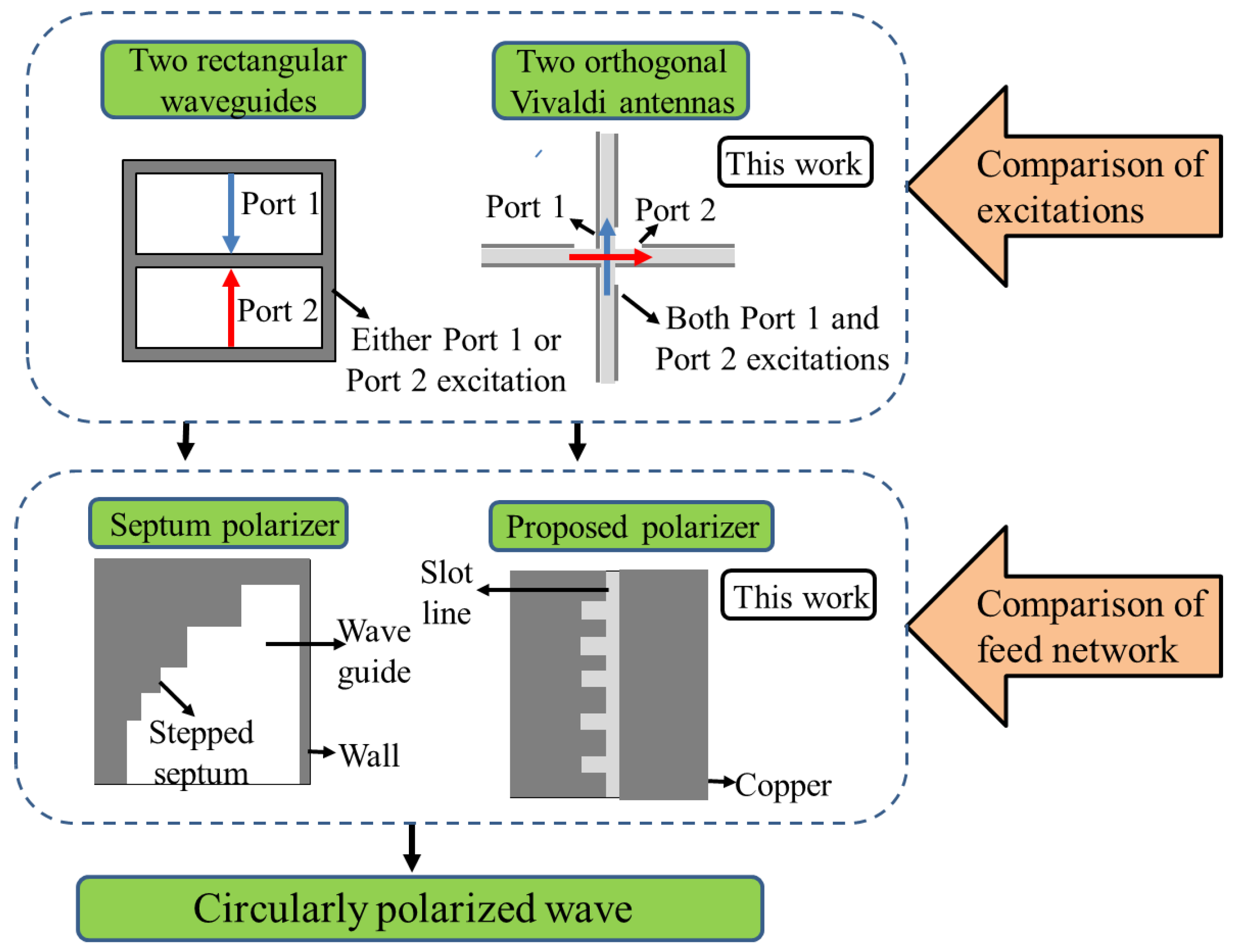
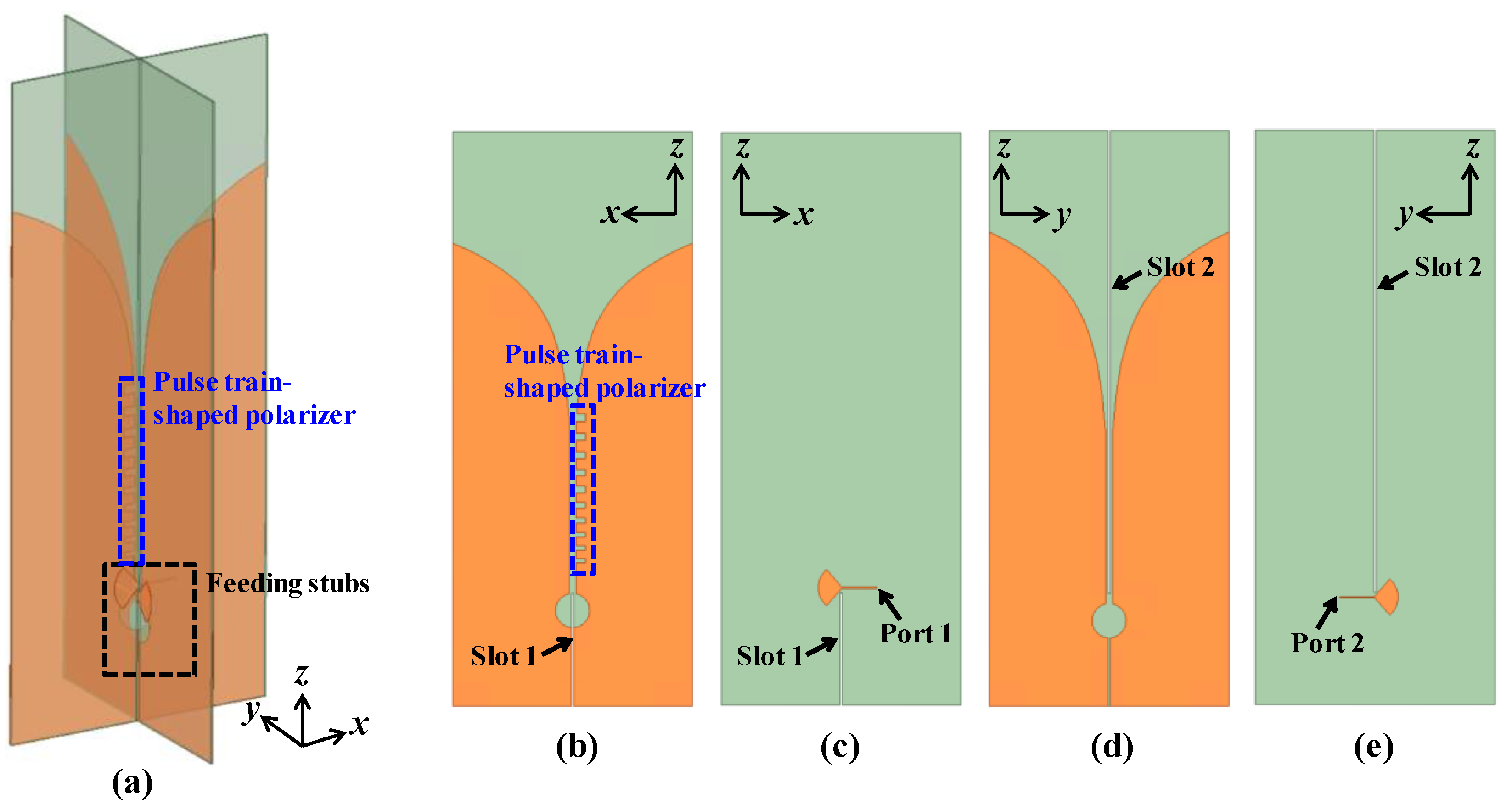
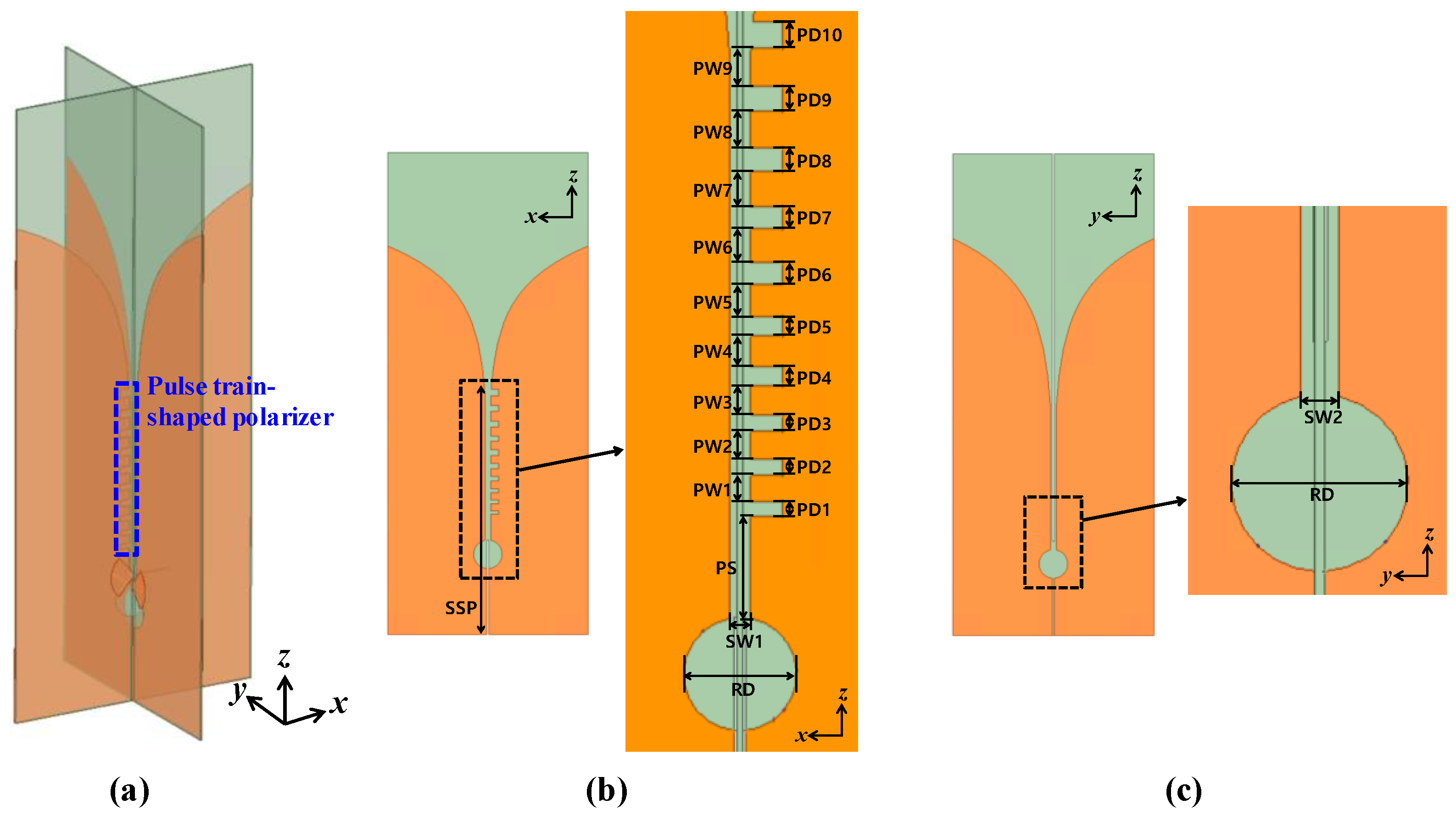

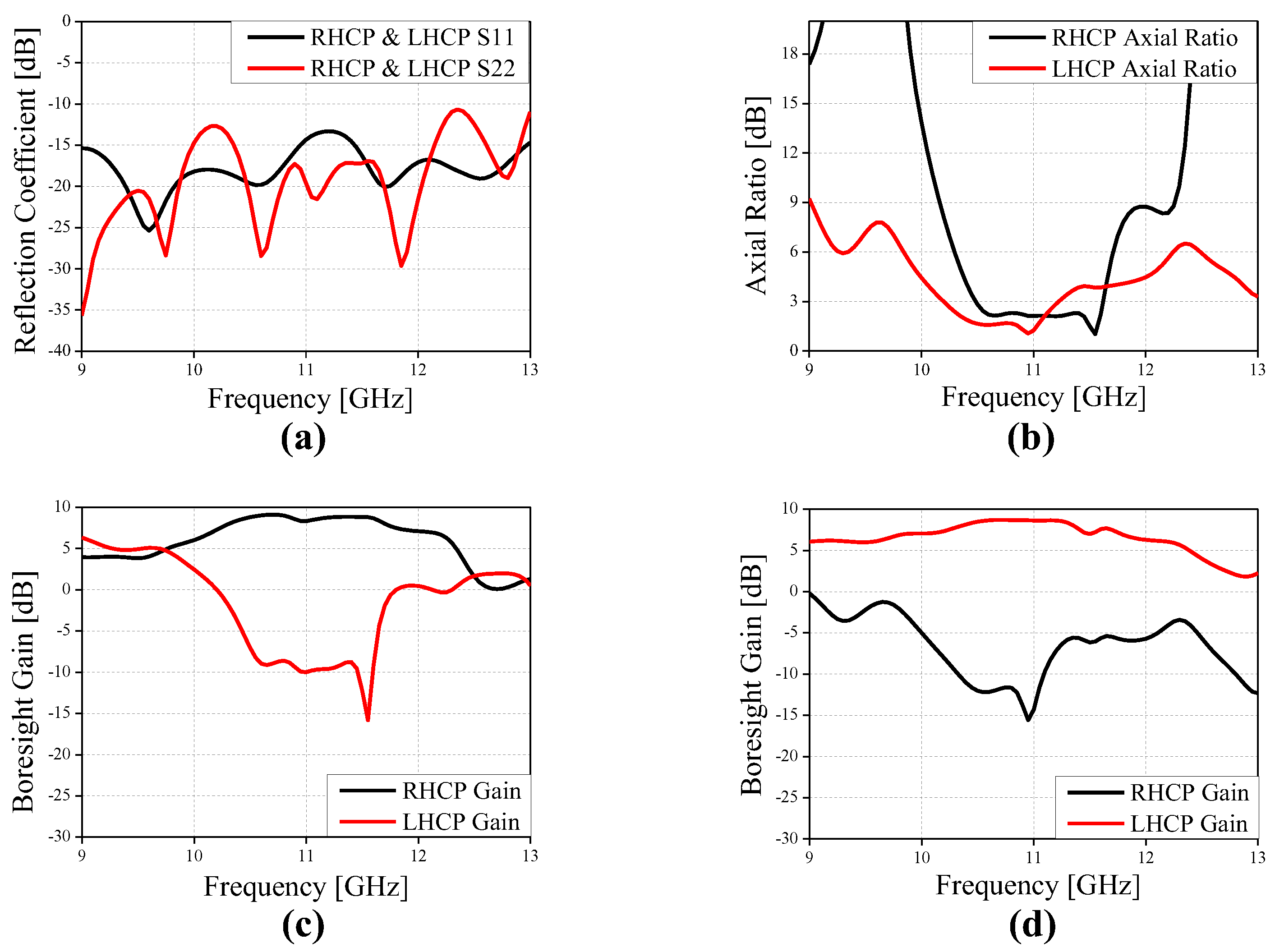
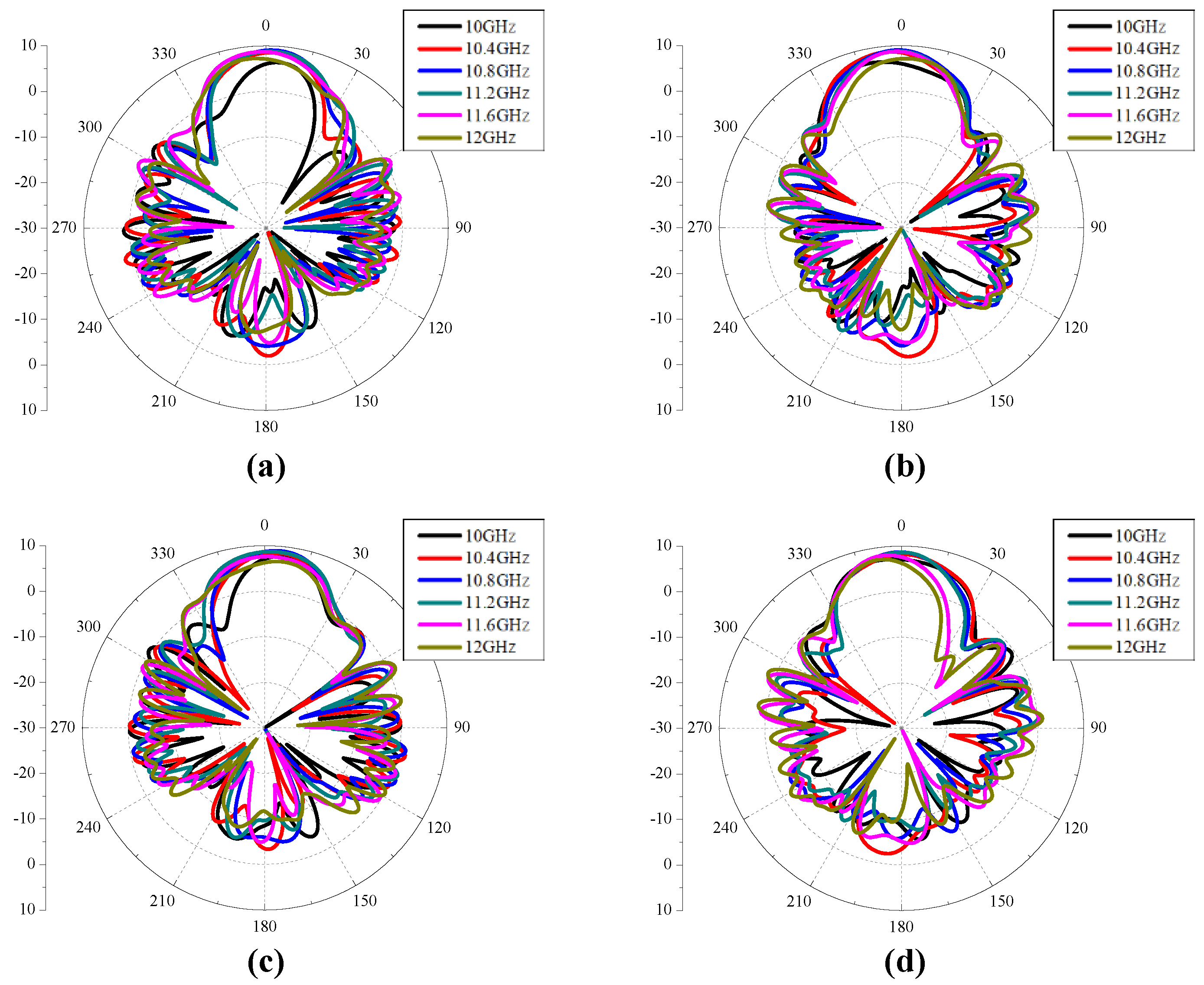
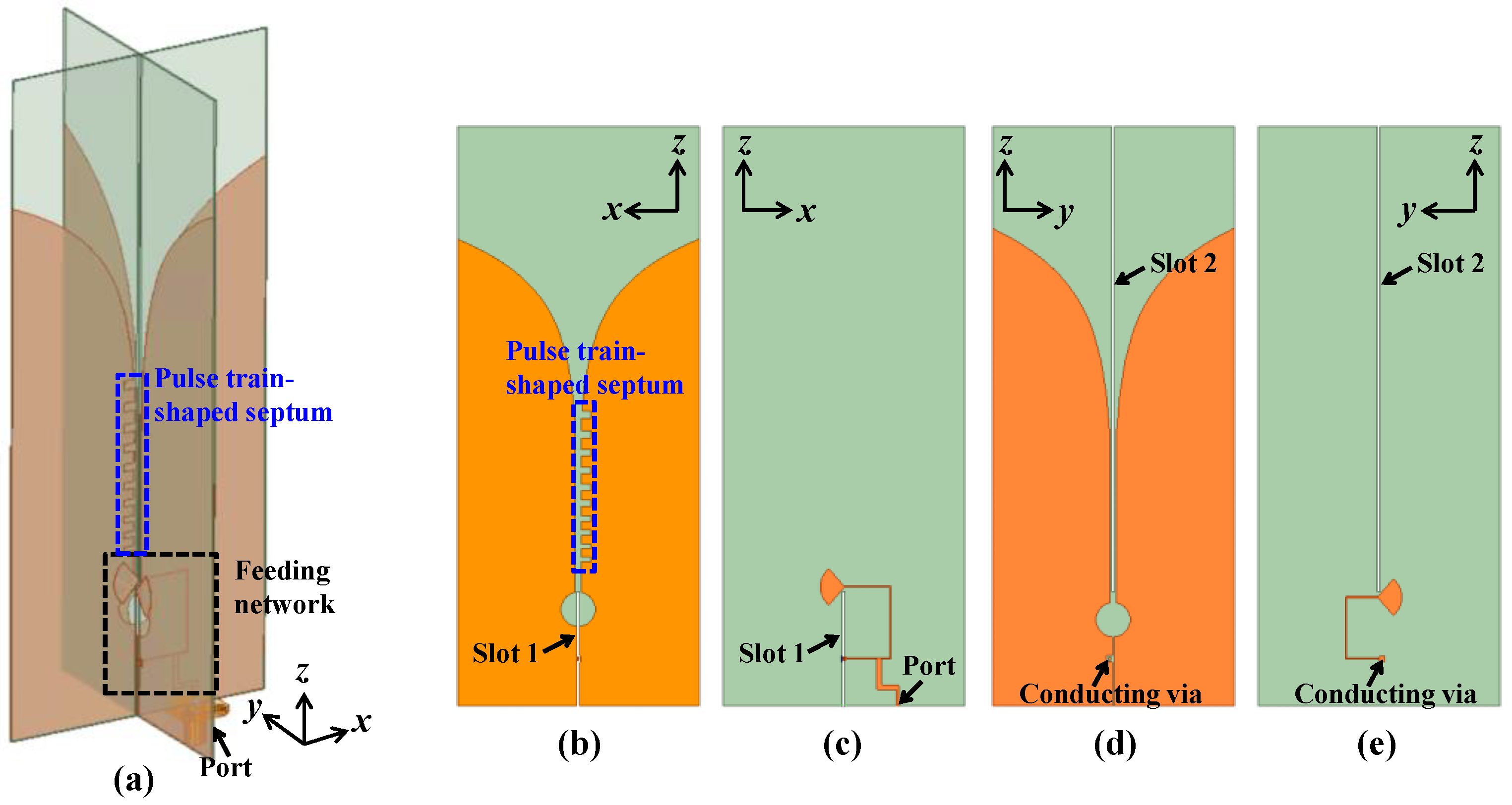
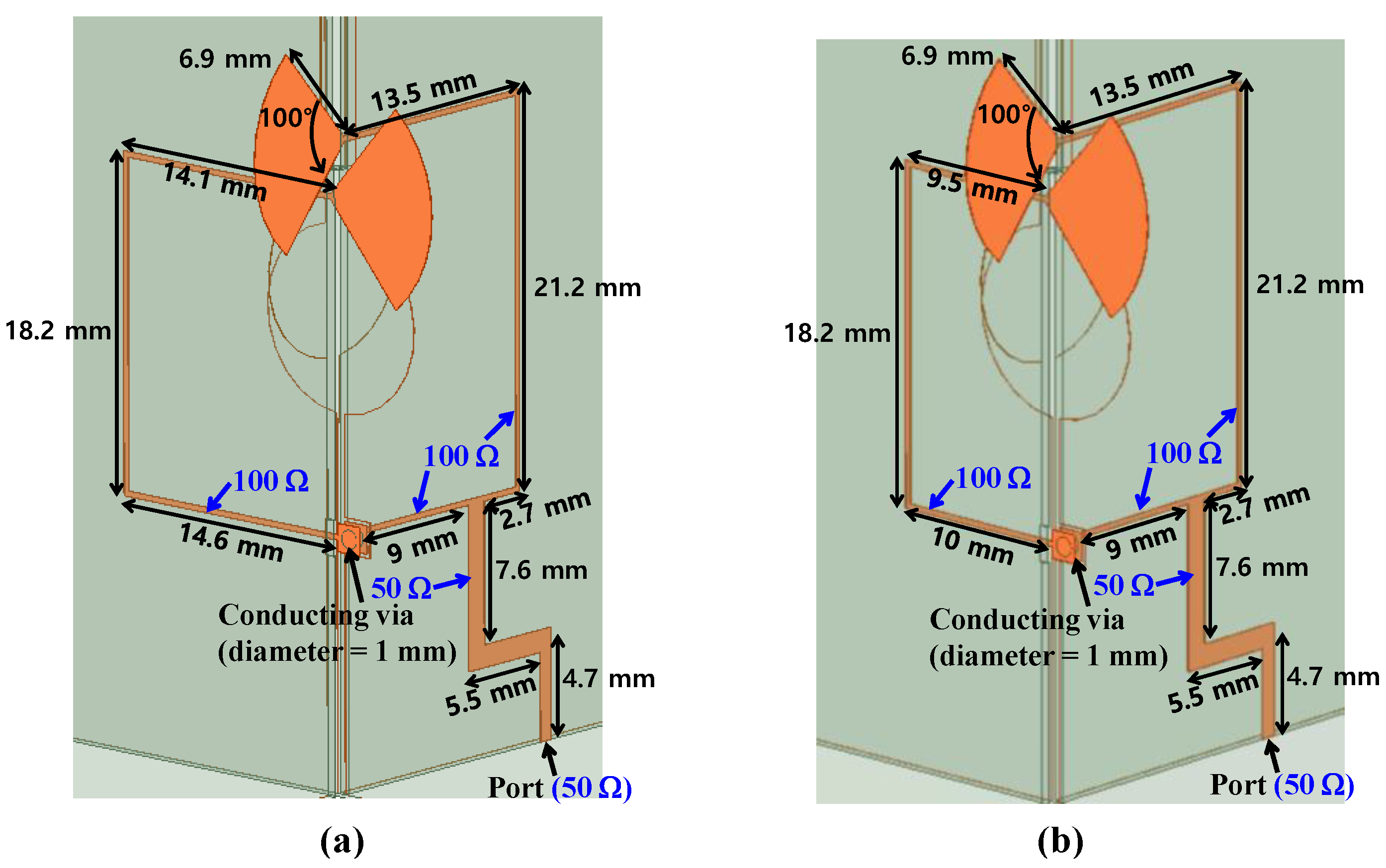
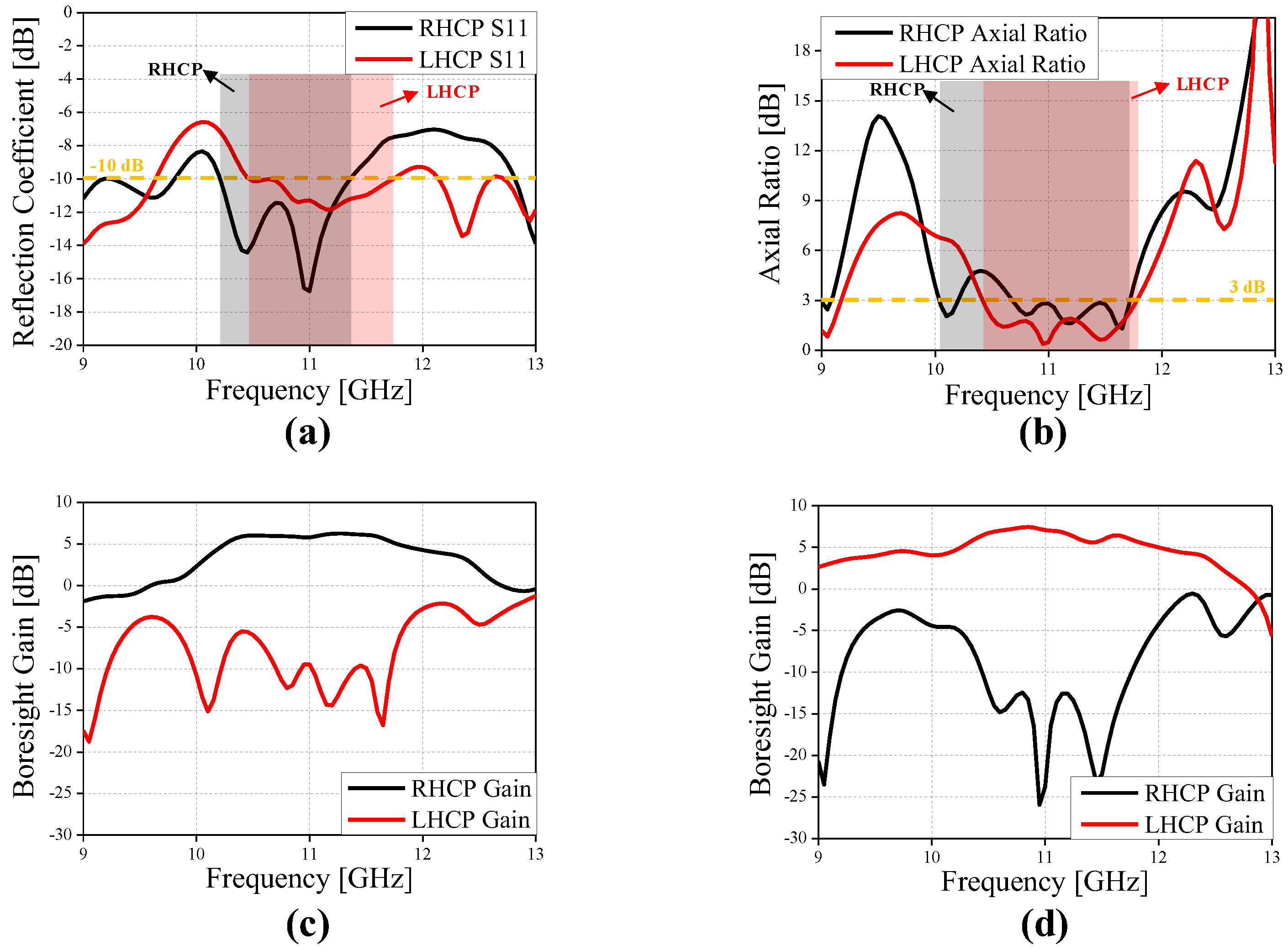
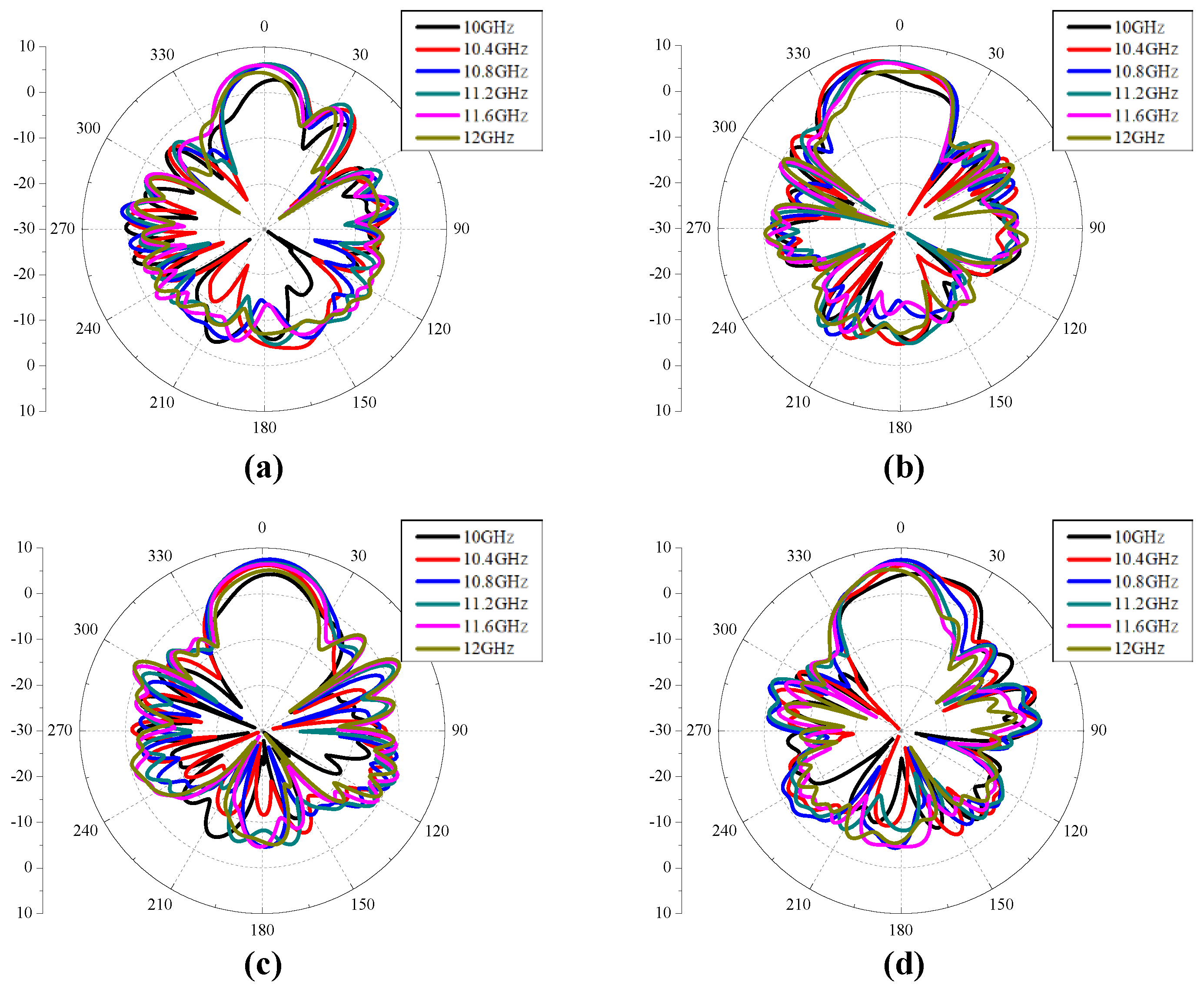


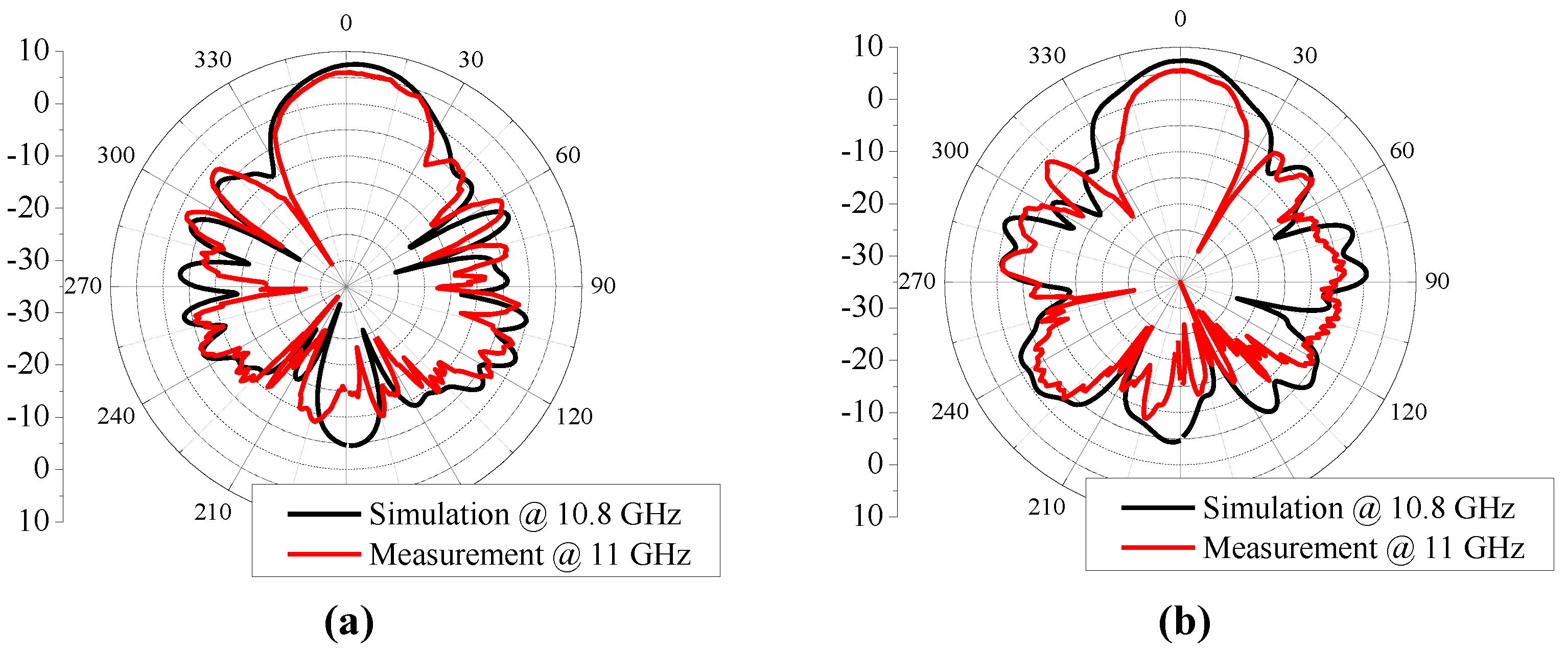
| Parameters | Dimension | Parameters | Dimension |
|---|---|---|---|
| PS | 9 mm | SSP | 85 mm |
| PD1 | 1.29 mm | SW1 | 1.9 mm |
| PW1 | 2.34 mm | SW2 | 2.09 mm |
| PDadd | 0.11 mm | φ1 | 60° |
| PWadd | 0.13 mm | φ2 | 68.9° |
Disclaimer/Publisher’s Note: The statements, opinions and data contained in all publications are solely those of the individual author(s) and contributor(s) and not of MDPI and/or the editor(s). MDPI and/or the editor(s) disclaim responsibility for any injury to people or property resulting from any ideas, methods, instructions or products referred to in the content. |
© 2024 by the authors. Licensee MDPI, Basel, Switzerland. This article is an open access article distributed under the terms and conditions of the Creative Commons Attribution (CC BY) license (https://creativecommons.org/licenses/by/4.0/).
Share and Cite
Kim, I.; Lee, S.-G.; Nam, Y.-H.; Lee, J.-H. Circularly Polarized Vivaldi Antennas Integrated with Septum-like Polarizer. Sensors 2024, 24, 4346. https://doi.org/10.3390/s24134346
Kim I, Lee S-G, Nam Y-H, Lee J-H. Circularly Polarized Vivaldi Antennas Integrated with Septum-like Polarizer. Sensors. 2024; 24(13):4346. https://doi.org/10.3390/s24134346
Chicago/Turabian StyleKim, Ilkyu, Sun-Gyu Lee, Yong-Hyun Nam, and Jeong-Hae Lee. 2024. "Circularly Polarized Vivaldi Antennas Integrated with Septum-like Polarizer" Sensors 24, no. 13: 4346. https://doi.org/10.3390/s24134346
APA StyleKim, I., Lee, S.-G., Nam, Y.-H., & Lee, J.-H. (2024). Circularly Polarized Vivaldi Antennas Integrated with Septum-like Polarizer. Sensors, 24(13), 4346. https://doi.org/10.3390/s24134346







